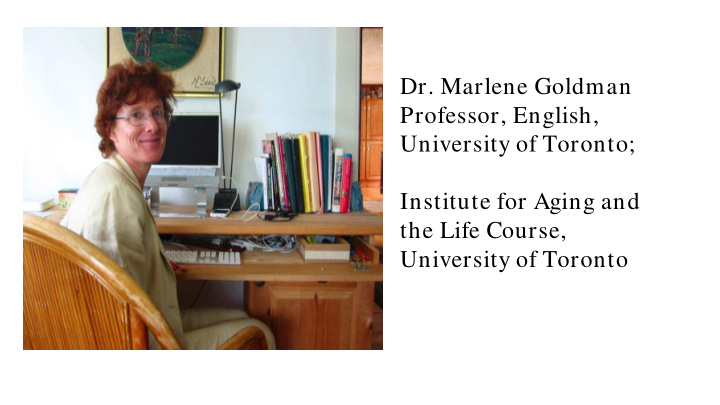



Dr. Marlene Goldman Professor, English, University of Toronto; Institute for Aging and the Life Course, University of Toronto
Alois Alzheimer b. 14 June 1864 d. 19 Dec. 1915
Emil Kraepelin b. 15 Feb. 1856 d. 7 Oct. 1926
Poor Nutrition
Lack of Education
Depression
Head Injury
Our Bodies and our Minds Keep the Score
Dr. Marlene Goldman Professor, English, University of Toronto; Website : marlenegoldman.ca Em ail : mgoldman@chass.utoronto. ca
Integrating the arts and humanities in care: Research, pedagogy, and practice PIA KONTOS, PHD SENIOR SCIENTIST, TORONTO REHABILITATION INSTITUTE-UNIVERSITY HEALTH NETWORK ASSOCIATE PROFESSOR, DALLA LANA SCHOOL OF PUBLIC HEALTH, UNIVERSITY OF TORONTO Institute for Life Course and Aging Seminar February 16, 2017
A CONVERGENCE OF THEMES • Embodiment and embodied practices • Embodied innovations in dementia care • Knowledge translation
EMBODIMENT & EMBODIED PRACTICES • Interrelationship between the primordial body, and culture, and social/historical contexts. • Merleau-Ponty and Bourdieu • Embodied selfhood • Challenges assumed loss of self with dementia
EMBODIED INNOVATIONS IN DEMENTIA CARE • Shift from dysfunction and control supporting intentional, meaningful and creative self-expression. • Education • Arts-based approaches: Elder-clowning • Citizenship and human rights
KNOWLEDGE TRANSLATION • Critical Realism and the Arts Research Utilization Model (CRARUM) • Critical social theory and literature • Drama
TEACHING • • Theory and Method for Qualitative Researchers: An Introduction • Advanced Research Seminar in Aging and the Life Course Directed Readings
THANK YOU! Contacts: pia.kontos@uhn.ca @PiaKontos
Bridging Arts & Health throughout the life course Julia Gray, PhD Artistic Director, Possible Arts Post Doctoral Fellow, Holland Bloorview Kids Rehab jgray@hollandbloorview.ca
Ar Arts-based KT a and nd C Communi unity Eng ngagement nt To open up conversations with community members about misconceptions and injustices in the world Arts/theatre as a frame to explore experiences, concepts and ideas, and overturn assumptions • in order to make change, we need to understand why and how we do things a certain way in the first plac e
Crack cked ed: new ew l light on d dem emen entia Pla laywrig ight/dir irector : Julia Gray Hea ealth Res esea earcher ers : Drs Sherry Dupuis, Pia Kontos, Gail Mitchell and Christine Jonas-Simpson Actors/Co-cre reators rs : Susan Applewhaite, Lori Nancy Kalamanski, Mary Ellen MacLean, Tim Machin, Claire Frances Muir, Mark Prince, David Talbot To cha halleng nge “the he discour urse of t tragedy and nd loss” tha hat is domina nant nt regar arding dementia a an and as associat ated car are prac actices
Crack cked ed: new ew l light on d dem emen entia Act ctors : Susan Applewhaite, Lori Nancy Kalamanski, Tim Machin, Mary Ellen MacLean, Claire Frances Muir, Andy Pogson, David Talbot Pho hotography phy : Dahlia Katz
Exploring Crea eative P e Proces cesses es Exploring the ways people make and engage with arts practices • what that means for people’s lives, how they express themselves and for people’s health more broadly. PhD hD Stud udy: explored the ways that artist-researchers draw on their bodies and imaginations through their creative work and the ways they do this vulnerably and bravely
Exploring Crea eative P e Proces cesses es An Aesthetic ic of Rela latio ionalit lity • an aesthetic space where a multiplicity of people are invited to imaginatively and foolishly (or vulnerably-bravely) explore the interrelationship among our bodies (as physical, emotional, sensory), actions and social/cultural/historical spaces • provides a frame to be able to design and plan a research-informed theatre project, as well as for evaluation and assessment
Pos ost D Doc octor oral Fellow ow: H Hol olland Bloor oorview • to engage the broader public in conversations about misconceptions about kids living with disabilities through the arts • to look at the ways art is made or engaged with in rehabilitation settings, specifically by and with kids living with disabilities
Thank you! Julia Gray, PhD jgray@hollandbloorview.ca @PossibleArts
Recommend
More recommend